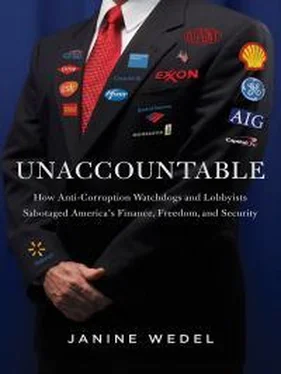Dominant finance’s excessive influence and favoring of “short-term shareholder value and large-scale gambling . . . has actually diverted, transferred, and extracted wealth from productive enterprises, workers, houses, and communities, generating rampant socioeconomic inequality not seen since the Great Depression,” argues anthropologist of finance Karen Ho (Karen Ho, “Occupy Finance and the Paradox/Possibilities of Productivity.” Fieldsights—Theorizing the Contemporary, Cultural Anthropology Online, May 15, 2012 [http://www.culanth.org/?q=node/573]). She adds: “And yet, in explicitly non-ironic terms, Wall Street actors and advocates continually naturalize and make direct claims about their connection to social purpose through production.”
19. With regard to the U.S. Securities and Exchange Commission (SEC), see this July 1997 question-and-answer commentary that the SEC issued six months after adopting new rules for derivatives accounting, which included VaR: Office of the Chief Accountant & the Division of Corporation Finance, “Questions and Answers About the New ‘Market Risk’ Disclosure Rules.” U.S . Securities and Exchange Commission, July 31, 1997 (http://www.sec.gov/divisions/corpfin/guidance/derivfaq.htm#qvar).
With regard to the Bank of International Settlements, VaR was part of the first pillar of the Basel II international banking standards adopted around the same time (Bank for International Settlements, “Part 2: The First Pillar—Minimum Capital Requirements” [http://www.bis.org/publ/bcbs128b.pdf]). In 2009, the New York Times described how the banks’ own propriety VaR models became part of the regulatory framework. Joe Nocera, “Risk Mismanagement.” New York Times, January 2, 2009, http://www.nytimes.com/2009/01/04/magazine/04risk-t.html?pagewanted=all.
In the late 1990s, as the use of derivatives was exploding, the [SEC] ruled that firms had to include a quantitative disclosure of market risks in their financial statements for the convenience of investors, and VaR became the main tool for doing so. Around the same time, [the] Basel Committee on Banking Supervision went even further to validate VaR by saying that firms and banks could rely on their own internal VaR calculations to set their capital requirements. So long as their VaR was reasonably low, the amount of money they had to set aside to cover risks that might go bad could also be low.
20. Joe Nocera, “Risk Mismanagement.” New York Times, January 2, 2009, http://www.nytimes.com/2009/01/04/magazine/04risk-t.html?pagewanted=all.
21. With regard to VaR as a risk management tool, this article presents the basic story: Joe Nocera, “Risk Mismanagement.” New York Times, January 2, 2009 (http://www.nytimes.com/2009/01/04/magazine/04risk-t.html?pagewanted=all). Nocera writes:
Built around statistical ideas and probability theories that have been around for centuries, VaR was developed and popularized in the early 1990s by a handful of scientists and mathematicians—“quants,” they’re called in the business—who went to work for JPMorgan. . . . After pointing out that a Nobel Prize had been awarded for work that led to some of the theories behind derivative pricing and risk management, [Greenspan] said: “The whole intellectual edifice, however, collapsed in the summer of last year because the data input into the risk-management models generally covered only the past two decades, a period of euphoria. Had instead the models been fitted more appropriately to historic periods of stress, capital requirements would have been much higher and the financial world would be in far better shape today, in my judgment.” Well, yes. . . . People tend not to be able to anticipate a future they have never personally experienced.
With regard to risk, see the work of economic historian Harold James who points out: “. . . calculations about likely risks . . . are terribly . . . misleading. If we think there’s one-in-a-1000-year chance of something happening, we’re inclined to ignore it. But then we find suddenly that these one-in-a-1000-year chances . . . seem to be happening every 10 minutes. . . .” (Harold James, speaking at the 2011 Institute for New Economic Thinking conference in Bretton Woods, New Hampshire, organized by the Institute for New Economic Thinking. See: Harold James, “The Emerging Political and Economic Order: What Lies Ahead?” Presented at Bretton Woods Conference, Institute for New Economic Thinking, April 8, 2011 [http://ineteconomics.org/net/video/playlist/conference/bretton-woods/B]; Janine R. Wedel, “Capitalism’s Crisis Within, and How Larry Summers Still Doesn’t Get It.” Huffington Post , April 21, 2011).
22. Quoted in Joe Nocera, “Risk Mismanagement.” New York Times, January 2, 2009, http://www.nytimes.com/2009/01/04/magazine/04risk-t.html?pagewanted=all.
23. Jonathan Weil, “Hardy har VAR: How JPMorgan is like Enron: Value-at-risk measurement proved to be way off for both companies.” InvestmentNews, May 18, 2012 (http://www.investmentnews.com/article/20120518/FREE/120519926#).
24. Gillian Tett, “An Anthropologist on Wall Street.” Fieldsights—Theorizing the Contemporary, Cultural Anthropology Online, May 16, 2012 (http://www.culanth.org/?q=node/580).
25. Bill Maurer, quoted in Janine R. Wedel, “Shadow Elite: Derivatives, A Horror Story.” Huffington Post , May 20, 2010 (http://www.huffingtonpost.com/janine-r-wedel/emshadow-eliteem-derivati_b_583014.html).
26. Lawrence Summers, “The Commodity Futures Trading Commission Concept Release.” Testimony before the Senate Committee on Agriculture, Nutrition, and Forestry, 105th Congress, July 30, 1998 (http://ustreas.gov/press/releases/rr2616.htm).
27. I spoke with Sony Kapoor on April 11, 2014 at the Institute for New Economic Thinking Annual Conference in Toronto. More on Kapoor can be found at re/define.org.
28. E-mail message from William White, May 13, 2014.
29. Think, for instance, of Edward Snowden, who exposed many U.S. government secrets while working for a government contractor, Booz Allen Hamilton, an established company with a long history of contracting.
30. We take up the issue of government contracting in Chapter 6. See also Janine R. Wedel, Shadow Elite: How the World’s New Power Brokers Undermine Democracy, Government, and the Free Market. New York: Basic Books, 2009, pp. 73-109 (http://janinewedel.info/books.html); and Janine R. Wedel, “Selling Out Uncle Sam: How the Myth of Small Government Undermines National Security.” New America Foundation, August 2010 (http://www.newamerica.net/sites/newamerica.net/files/policydocs/SellingOutUncleSamAug10.pdf).
31. The New York Times has reported on the troubling use of “little-known private databases” that is effectively keeping perhaps 10 million low-income Americans from getting even a bank account, because they ended up in these databases for often very small credit offenses. A low-income financial counselor, Kristen Euretig, said this: “Most of my clients have no idea these databases exist, let alone what they did to end up in them.” New York Times , July 30, 2013 (http://dealbook.nytimes.com/2013/07/30/over-a-million-are-denied-bank-accounts-for-past-errors/).
32. In testimony before the Privacy and Civil Liberties Oversight Board, an independent agency within the Executive Branch, the NSA’s general counsel affirmed that tech companies were aware of, and helped with, data collection under the s0-called PRISM program. Alexis Kleinman, “NSA: Tech Companies Knew About PRISM The Whole Time.” Huffington Post , March 20, 2014 (http://www.huffingtonpost.com/2014/03/20/nsa-prism-tech-companies_n_4999378.html).
Google has denied its involvement in turning over its users’ personal data to NSA (although investigative reporting has tried to refute this). Director of National Intelligence James Clapper, several months before the NSA revelations of June 2013, also denied in congressional testimony that the NSA was gathering such information. (See, for instance, Dan Roberts, “Intelligence chief James Clapper apologizes to Congress for ‘erroneous’ NSA claims.” The Raw Story, July 1, 2013 [http://www.rawstory.com/rs/2013/07/01/intelligence-chief-james-clapper-apologizes-to-congress-for-erroneous-nsa-claims/].)
Читать дальше












